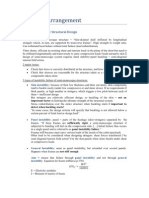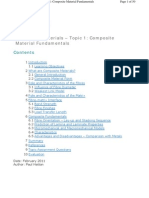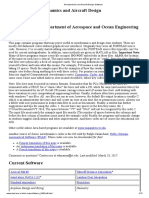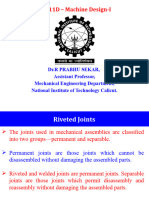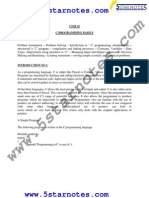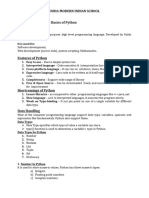NX Conditional Logic Statements
Uploaded by
marcoNX Conditional Logic Statements
Uploaded by
marcoSherpa Design, Inc.
107 SE Washington Street
Suite 216-J
Portland, Oregon 97214
www.sherpa-design.com
503.771.3570 Tel
503.771.3575 Fax
UG CONDITIONAL LOGIC STATEMENTS
If you want to add some intelligence to your Unigraphics models to prevent erroneous input through
expression list edits, logic statements can help. You can set upper/lower limits for accepted inputs, have
other expression values change based upon anothers value, or have other checks enforced. They can be
very powerful for developing re-usable design tools and help prevent crashes when an entered value
exceeds the models design intent.
OVERVIEW:
Allows you to embed IF-THEN-ELSE statements into parameter evaluation
Using dummy variables, you can build in checks for the user input routine (e.g. if whats entered
satisfies some criteria use it, otherwise use some default value)
Uses standard logic expressions (AND, OR, EQUAL TO, LESS THAN, GREATER THAN OR EQUAL TO,
etc)
Takes some forethought and planning to be valuable (see MODEL PLAN)
TO USE IT:
Logic statements can be entered either directly in the expression list, or can be applied in the spreadsheet.
The general format for them is:
EXPRESSION= if(conditionals)(value A)else(value B)
Logical operators in UG
> Greater Than
< Less Than Example: We want the thickness of a plate to always be greater than 1
>= Greater Than or Equal inch, but not larger than 4 inches. The user through the expression list
enters the plate thickness. We want our model to check to make sure that
<= Less Than or Equal the value entered always satisfies our thickness criteria, or else defaults to
== Equal a thickness of 1 inch.
!= Not Equal We create a dummy expression called Plate_th. (The capitalization will
! Negate put it near the top of the expression list, which the user will see first when
they go to edit the expression.) We create a working expression called
&& AND
z_thick that will actually drive the model and will be at the end of the
|| OR expression list. Here is what our expressions will look like:
Plate_th=2
p0=0.0
p1=.875
z_thick=if(Plate_th>=1&&Plate_th<=4)(Plate_th)else(1)
For the value of z_thick, if Plate_th is greater than or equal to 1 AND less than or equal to 4, use the value of
Plate_th as it is entered, otherwise use a value of 1. In this case, the users input satisfies our criteria so the
plate thickness would be 2,
CAVEATS:
Great way to start building design intent into models
Conditionals can be nested to create multiple evaluations and reference other conditional
expressions
Using the spreadsheet affords even more evaluation power using cells that can do more math and
reference more data.
2003 Sherpa Design, Inc. All rights reserved.
You might also like
- The Design of Aircraft Landing Gear: February 2021No ratings yetThe Design of Aircraft Landing Gear: February 202125 pages
- CATIA Tutorial 1-Parameters Wings EmpennageNo ratings yetCATIA Tutorial 1-Parameters Wings Empennage27 pages
- Lofting Requirement and Technique For A Ferrocement HullNo ratings yetLofting Requirement and Technique For A Ferrocement Hull8 pages
- Design, Static Structural and Modal Analysis of Aircraft Wing (Naca 4412) Using Anasys Workbench 14.5No ratings yetDesign, Static Structural and Modal Analysis of Aircraft Wing (Naca 4412) Using Anasys Workbench 14.511 pages
- R Modal Analysis of Aircraft Wing Using Ansys PDFNo ratings yetR Modal Analysis of Aircraft Wing Using Ansys PDF6 pages
- Structural Stress Analysis of An Automotive Vehicle ChassisNo ratings yetStructural Stress Analysis of An Automotive Vehicle Chassis6 pages
- Machining Fixture For Adaptive CNC Machining Process of Near-Net-Shaped Jet Engine Blade100% (1)Machining Fixture For Adaptive CNC Machining Process of Near-Net-Shaped Jet Engine Blade18 pages
- Wing Rib Stress Analysis and Design OptimizationNo ratings yetWing Rib Stress Analysis and Design Optimization5 pages
- Answer: Catia V5-Interview Questions (Part-1)No ratings yetAnswer: Catia V5-Interview Questions (Part-1)67 pages
- Aircraft Aerodynamic Design With Computational Software (Rizzi, Oppelstrup)No ratings yetAircraft Aerodynamic Design With Computational Software (Rizzi, Oppelstrup)619 pages
- Catia Syllabus v5r16 Basics Ilt Tata TechnologiesNo ratings yetCatia Syllabus v5r16 Basics Ilt Tata Technologies3 pages
- Rd-3150: Seat Model With Dummy Using HypercrashNo ratings yetRd-3150: Seat Model With Dummy Using Hypercrash45 pages
- Operation and Performance Measurement On Engines in Sea Level Test Facilitiesd CNo ratings yetOperation and Performance Measurement On Engines in Sea Level Test Facilitiesd C177 pages
- Skin Stringers in An Aircraft 160107143212 PDFNo ratings yetSkin Stringers in An Aircraft 160107143212 PDF17 pages
- Aerodynamics and Aircraft Design SoftwareNo ratings yetAerodynamics and Aircraft Design Software13 pages
- Conceptual Design of A Business Jet Airc PDFNo ratings yetConceptual Design of A Business Jet Airc PDF6 pages
- Durability Assessments of Motorcycle Handlebars Ken-Yuan Lin, 2005 XXXXXNo ratings yetDurability Assessments of Motorcycle Handlebars Ken-Yuan Lin, 2005 XXXXX25 pages
- Edu Cat en Kwe FF v5r17 Knowledge Expert Student GuideNo ratings yetEdu Cat en Kwe FF v5r17 Knowledge Expert Student Guide66 pages
- Copie de Kenjo - Recruitment Tracker (2)No ratings yetCopie de Kenjo - Recruitment Tracker (2)41 pages
- Java Coding Style Short Cuts and BasicsNo ratings yetJava Coding Style Short Cuts and Basics14 pages
- Preparation of Papers For IEEE T and J: Ransactions OurnalsNo ratings yetPreparation of Papers For IEEE T and J: Ransactions Ournals6 pages
- 1901005-Problem Solving and Python ProgrammingNo ratings yet1901005-Problem Solving and Python Programming10 pages
- Amaleaks Blogspotcom Prog113a Grade 12 Week1 20No ratings yetAmaleaks Blogspotcom Prog113a Grade 12 Week1 20167 pages
- Lecture1 - Modelling-Computers-Error Analysis - 19feb2024 - NK - v1No ratings yetLecture1 - Modelling-Computers-Error Analysis - 19feb2024 - NK - v175 pages
- 164 - CS6456 Object Oriented Programming - Notes 1No ratings yet164 - CS6456 Object Oriented Programming - Notes 1179 pages
- IT-104 Programming Fundamental Course OutlineNo ratings yetIT-104 Programming Fundamental Course Outline8 pages
- 01.Introduction to Data, Data Structure, Algortihm, Time and Space ComplexityNo ratings yet01.Introduction to Data, Data Structure, Algortihm, Time and Space Complexity111 pages
- Tutorial For Processing: Animation Using Draw, Assignment, and If StatementsNo ratings yetTutorial For Processing: Animation Using Draw, Assignment, and If Statements7 pages
- Algorithms, Flowcharts, Data Types and PseudocodeNo ratings yetAlgorithms, Flowcharts, Data Types and Pseudocode49 pages
- (100% Off) Complete Python Bootcamp For Everyone From Zero To Hero 2023No ratings yet(100% Off) Complete Python Bootcamp For Everyone From Zero To Hero 202329 pages













